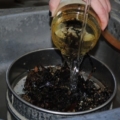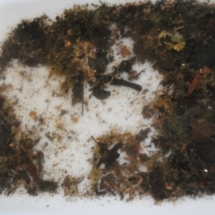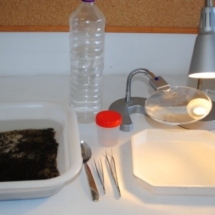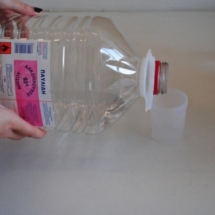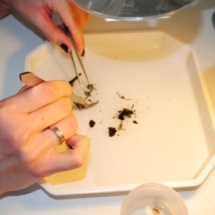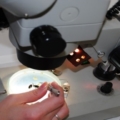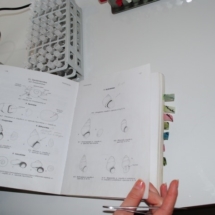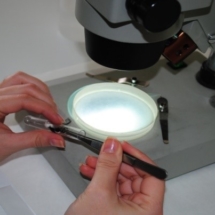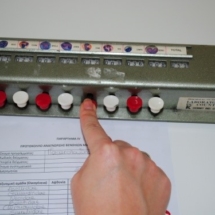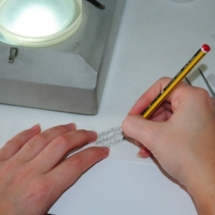Sorting of benthic macroinvertebrates comprises the following steps:
- First, each sorter fills the Analysis/Sorting Protocol referring to benthic macroinvertebrates’ sorting. Some data should be written on the above protocol like the sample code, name of the sorter, the start and the end date of the sample’s analysis, the type of substrate, any comments (whether the sample is clear or if it contains any plant parts or parts from the substrate). A picture depicting the density of the sample must be also taken,
- Εach sample is thoroughly rinsed with tap water through a 500 μm pore sieve, so as the fine material to be removed (Figure 1).
Figure 1: A 500μm pore sieve. - Then, the sample is placed in clean water, in order the organisms not to be dehydrated. The sieve and the jar are carefully checked to collect all organisms from the sample.
- The procedure of benthic macroinvertebrates’ sorting is done in the entire sample (Fig. 2a) with the help of magnifiers and table lamps and in subsamples for convenience (Fig. 2b). The individuals of each station are placed into jars fulfilled with alcohol solution 75% vol. in order the organisms to be preserve. In each jar a label with data of the sample is noted. All the organisms from zoobenthos are being carefully removed from all subsamples. The remaining material (Fig. 2c) (substrate) is then placed in a jar with alcohol solution75% vol., in order to be checked by an auditor. Additionally, all samples are rechecked by an independent auditor, so that no taxonomic group or individual has been omitted during the procedure.
Sample ready for sorting (a), Sorting equipment (b), Plastic container with alcohol solution for the preservation of benthic macroinvertabrates (c), Testing of a portion of the entire sample (d).
Then all the individuals from sorting are identified at the level of class/order/family that they belong to and their abundance is also calculated. The following are not identified:
- Insects’ pupae,
- Oligochaeta body parts (without the head),
- Empty cells without the body of the animal.
Figure 3: identification of benthic macroinvertebrates with help of stereoscope.
For the classification of benthic macroinvertebrates key books are used: (Fig. 4a):
- General (Campaioli et al., 1994; Tachet et al., 2000,),
- Photographic (Kriska, 2009; Patsia and Lazaridou, 2011) and
- Specific ones for insects (Ephemeroptera, Plecoptera, Trichoptera, Coleoptera, Diptera etc.)
At the end of the identification of all benthic macroinvertebrates, the organisms of each taxon are placed into test tubes (Fig. 4b) with 75% vol. alcohol solution, after counting their absolute abundance using a counter in order to avoid any mistakes in enumeration (Fig. 4c). The abundance is recorded in the Analysis/Identification Protocol
Once the identification is completed, all the tubes are checked by an auditor, to check if all taxonomic groups have been correctly identified and the abundance of the individuals has been correctly measured. After the audit is done, the initial taxonomist and the auditor should sign the Analysis/Identification Protocol. The total number of the samples are being re-examined by an independent auditor, in order to reduce any possible mistake on identification. At the end of all tests, the initial taxonomist transfers his/her results in the Identification database.
Fianally, test tubes are kept in the museum of benthic macroinvertebrates (http://river.bio.auth.gr/museum-material-of-benthic-macroinvertebrates/). Each tube carries all the relative information:class, order, family, sampling location and sampling date.
Key book recognition (a), Placing animals in test tube (b), Counting the abundance (c), Recording data on rice paper (d)
Campaioli, S, Ghetti PF, Minelli A & Ruffo S (1994). Manuale per il riconoscimento dei macroinvertebrati delle acque dolci italiane (Vol I, II). APR & B
Kriska G. (2009). “Freshwater Invertebrates in Central europe: A Field Guide, Springer, Jena, Germany
Patsia, A. & Lazaridou Μ. (2011). Water quality through the Directive 2000/60 E.C.: Guide for benthic invertebrates of running waters of Greece. ION, Athens.
Tachet H, Richoux P, Bournaud M and Usseglio-Polatera (2000). Invertébrés d’eau douce. Systématique, biologie, écologie. CNRS Editions, Paris, France.
